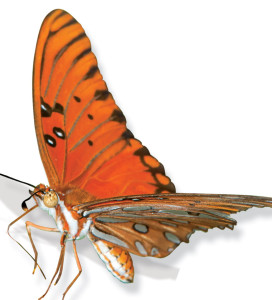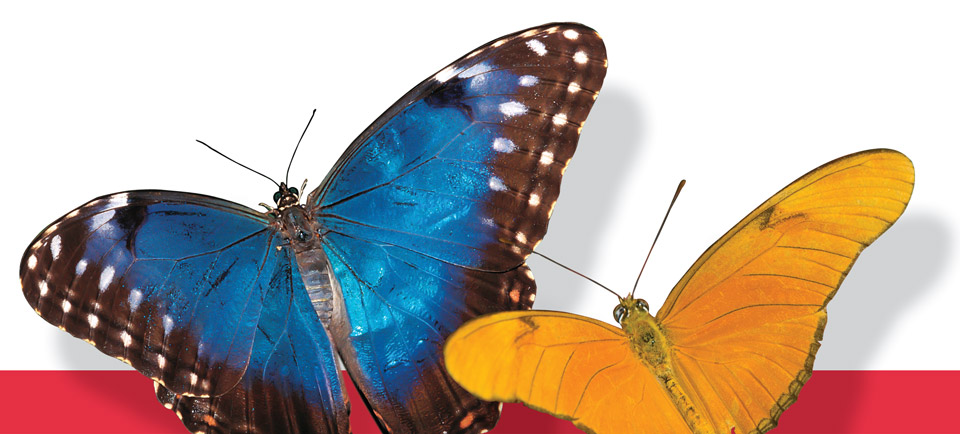The Butterfly Watchers
text and photos by Thor Janson.
Bird watching is big business. It’s been reported that there are more than 20 million aficionados who are serious about watching these feathered friends in their natural habitat. Birds are often very beautiful and as a group they display a great diversity of color, shapes and behavior.
 But there is another group of winged creatures, equally diverse and beautiful, that deserve more attention. I am referring to butterflies and their homologous nocturnal allies, the moths. The diversity of butterflies in Guatemala rivals that of birds. There are more than 600 species, ranging from hummingbird-sized morphos, Uranias and swallowtails to the diminutive skippers, hairstreaks and heliconians. Butterflies come in a multitudinous variety of shapes, colors, sizes and surprising combinations of patterns. There are still many butterfly species to be discovered in remote, mountain valley microclimatic zones and in extant swamps and jungles.
But there is another group of winged creatures, equally diverse and beautiful, that deserve more attention. I am referring to butterflies and their homologous nocturnal allies, the moths. The diversity of butterflies in Guatemala rivals that of birds. There are more than 600 species, ranging from hummingbird-sized morphos, Uranias and swallowtails to the diminutive skippers, hairstreaks and heliconians. Butterflies come in a multitudinous variety of shapes, colors, sizes and surprising combinations of patterns. There are still many butterfly species to be discovered in remote, mountain valley microclimatic zones and in extant swamps and jungles.
I was thinking about how I might help to promote butterfly watching as a hobby in Guatemala, and I happened to bump into one of our foremost bird tourism guides, Josué de León, who is based at Los Tarrales Reserve in the pristine forest on the upper slope of volcán Atitlán. He was already busy compiling a catalogue of local butterfly species.
Butterfly watching is much the same sort of sport as bird watching. Butterflies of course are usually much smaller than birds but are
also more easily approached. So with binoculars or a spotting scope you can get excellent views of these creatures.
Butterflies (and moths) have the added fascinating characteristic that they begin their lives as caterpillars and then, in a near miraculous transformation, seal themselves up for a time in a pod-like chrysalis to undergo metamorphosis and sometime later emerge, reborn so to speak, as butterflies.
Children especially are utterly fascinated by this process, and it is something that they can see and experience with relative ease at one of the region’s butterfly houses, such the Atitlán Butterfly Sanctuary in Panajachel.
One of the best places I have found in all Guatemala to view the Lepidoptera is at the Lachua Lagoon National Park in northern Alta Verapáz department. There are times when the area adjacent to the lakeshore is absolutely brimming with multihued butterflies; you can’t believe your eyes at the kaleidoscopic cloud of psychedelic, polychromatic fluttering of wings surrounding you.
Lachua Lagoon is also a great place to camp for a few days. The authorities had the wisdom to prevent a road being built to access the shore. It is necessary to walk for an hour or so along the jungle path to the campground and lodge. What this means is that you can enjoy pristine natural surroundings. One word of advice: Bring plenty of insect repellant as the area tends to be pretty buggy.
Everyone has seen moths at night, as they are attracted by bright lights and often flit to and fro under streetlights. By taking a hint from the method used by biologists to collect moths at night, it is easy to hang a white sheet over a line and then shine a bright light under a forest canopy at night. It won’t be long before various nocturnal insects alight upon the illuminated sheet. As for diurnal butterfly watching, the protocol is pretty much the same as for bird watching: Just head out, binoculars and spotting scopes at the ready, and explore the environs of any forest, and you will be rewarded by many viewing opportunities.
As lepidopterous pursuits become more serious, it is useful to become familiar with butterfly feeding habits, which vary widely. Some butterflies are attracted by rotting fruit, others by flower nectar and others by dung. On a hot dry day it is common to find many species hanging out by the banks of rivers or lakes, where they sip water through their specially designed tubular proboscises. Another strategy is to make your own butterfly feeding station by setting out some overripe fruits and a few small bowls of sweetened water and some stale beer, as many varieties are attracted by the smell of fermented matter. 
For guided butterfly- or bird-watching adventures, contact Josué de León / Los Tarrales Reserve, tel: 5919-8882. Also inquire about guided school groups with the hope that the experience will instill in students a love of nature.


